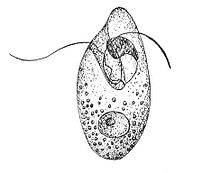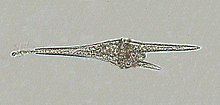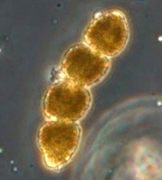
Predatory dinoflagellates are predatory heterotrophic or mixotrophic alveolates that derive some or most of their nutrients from digesting other organisms. About one half of dinoflagellates lack photosynthetic pigments and specialize in consuming other eukaryotic cells, and even photosynthetic forms are often predatory.
Organisms that derive their nutrition in this manner include Oxyrrhis marina, which feeds phagocytically on phytoplankton, Polykrikos kofoidii, which feeds on several species of red-tide and/or toxic dinoflagellates, Ceratium furca, which is primarily photosynthetic but also capable of ingesting other protists such as ciliates, Cochlodinium polykrikoides, which feeds on phytoplankton, Gambierdiscus toxicus, which feeds on algae and produces a toxin that causes ciguatera fish poisoning when ingested, and Pfiesteria and related species such as Luciella masanensis, which feed on diverse prey including fish skin and human blood cells. Predatory dinoflagellates can kill their prey by releasing toxins or phagocytize small prey directly.
Some predatory algae have evolved extreme survival strategies. For example, Oxyrrhis marina can turn cannibalistic on its own species when no suitable non-self prey is available, and Pfiesteria and related species have been discovered to kill and feed on fish, and since have been (mistakenly) referred to as carnivorous "algae" by the media.
Pfiesteria hysteria
The media has applied the term carnivorous or predatory algae mainly to Pfiesteria piscicida, Pfiesteria shumwayae and other Pfiesteria-like dinoflagellates implicated in harmful algal blooms and fish kills. Pfiesteria is named after the American protistologist Lois Ann Pfiester. It is an ambush predator that utilizes a hit and run feeding strategy by releasing a toxin that paralyzes the respiratory systems of susceptible fish, such as menhaden, thus causing death by suffocation. It then consumes the tissue sloughed off its dead prey. Pfiesteria piscicida (Latin: fish killer) has been blamed for killing more than one billion fish in the Neuse and Pamlico river estuaries in North Carolina and causing skin lesions in humans in the 1990s. It has been described as "skinning fish alive to feed on their flesh" or chemically sensing fish and producing lethal toxins to kill their prey and feed off the decaying remains. Its deadly nature has led to Pfiesteria being referred to as "killer algae" and has earned the organism the reputation as the "T. rex of the dinoflagellate world" or "the Cell from Hell."
The prominent and exaggerating media coverage of Pfiesteria as carnivorous algae attacking fish and humans has been implicated in causing "Pfiesteria hysteria" in the Chesapeake Bay in 1997 resulting in an apparent outbreak of human illness in the Pocomoke region in Maryland. However, a study published the following year concluded the symptoms were unlikely to be caused by mass hysteria.
In popular culture


During the media coverage in the 1990s, Pfiesteria has been referred to as "super villain" and subsequently has been used as such in several fictional works. A Pfiesteria subspecies killing humans featured in James Powlik's 1999 environmental thriller Sea Change. In Frank Schätzing's 2004 science fiction novel The Swarm, lobsters and crabs spread the killer alga Pfiesteria homicida to humans.
In Yann Martel's 2001 novel Life of Pi, the protagonist encounters a floating island of carnivorous algae inhabited by meerkats while shipwrecked in the Pacific Ocean. At a book reading in Calgary, Alberta, Canada, Martel explained that the carnivorous algae island had the purpose of representing the more fantastical of two competing stories in his novel and challenge the reader to a "leap of faith."
In the 2005 National Geographic TV show Extraterrestrial, the alien organism termed Hysteria combines characteristics of Pfiesteria with those of cellular slime molds. Like Pfiesteria, Hysteria is a unicellular, microscopic predator capable of producing a paralytic toxin. Like cellular slime molds, it can release chemical stress signals that cause the cells to aggregate into a swarm which allows the newly formed superorganism to feed on much larger animals and produce a fruiting body that releases spores for reproduction.
See also
References
- Doyle, Jeff; Soltis, Douglas E.; Soltis, Pamela S. (1998). Molecular systematics of plants II: DNA sequencing. Boston: Kluwer Academic Publishers. ISBN 0-412-11121-7.
- Bhattacharya, Debashish; Olson, Laura Katz (2006). Genomics and evolution of microbial eukaryotes. Oxford : Oxford University Press. ISBN 0-19-856974-2.
- Whiteley AS, Burkill PH, Sleigh MA (1993). "Rapid method for cell cycle analysis in a predatory marine dinoflagellate". Cytometry. 14 (8): 909–15. doi:10.1002/cyto.990140809. PMID 7507024.
- Jeong HJ, Kim SK, Kim JS, Kim ST, Yoo YD, Yoon JY (2001). "Growth and grazing rates of the heterotrophic dinoflagellate Polykrikos kofoidii on red-tide and toxic dinoflagellates". J. Eukaryot. Microbiol. 48 (3): 298–308. doi:10.1111/j.1550-7408.2001.tb00318.x. PMID 11411838. S2CID 27126586.
- Smalley GW, Coats DW (2002). "Ecology of the red-tide dinoflagellate Ceratium furca: distribution, mixotrophy, and grazing impact on ciliate populations of Chesapeake Bay". J. Eukaryot. Microbiol. 49 (1): 63–73. doi:10.1111/j.1550-7408.2002.tb00343.x. PMID 11908900. S2CID 20834759.
- Jeong HJ, Du Yoo Y, Kim JS, et al. (2004). "Mixotrophy in the phototrophic harmful alga Cochlodinium polykrikoides (Dinophycean): prey species, the effects of prey concentration, and grazing impact". J. Eukaryot. Microbiol. 51 (5): 563–9. doi:10.1111/j.1550-7408.2004.tb00292.x. PMID 15537091. S2CID 4641093.
- Centers for Disease Control and Prevention (CDC) (2006). "Ciguatera fish poisoning--Texas, 1998, and South Carolina, 2004". MMWR Morb. Mortal. Wkly. Rep. 55 (34): 935–7. PMID 16943762.
- Vogelbein WK, Lovko VJ, Shields JD, et al. (2002). "Pfiesteria shumwayae kills fish by micropredation not exotoxin secretion". Nature. 418 (6901): 967–70. Bibcode:2002Natur.418..967V. doi:10.1038/nature01008. PMID 12198545. S2CID 4388577.
- Jeong HJ, Ha JH, Yoo YD, et al. (2007). "Feeding by the Pfiesteria-like heterotrophic dinoflagellate Luciella masanensis". J. Eukaryot. Microbiol. 54 (3): 231–41. doi:10.1111/j.1550-7408.2007.00259.x. PMID 17552978. S2CID 614623.
- Wiley Interscience
- Martel CM, Flynn KJ (2008). "Morphological controls on cannibalism in a planktonic marine phagotroph". Protist. 159 (1): 41–51. doi:10.1016/j.protis.2007.05.003. PMID 17768088.
- ^ "AAAS Atlas of Population and Environment". Retrieved 2008-01-05.
- ^ Michael Greger (2006). Bird Flu: A Virus of Our Own Hatching. Lantern Books. ISBN 1-59056-098-1.
- Eichhorn, Susan E.; Raven, Peter H.; Evert, Ray Franklin (2005). Biology of plants. New York: W.H. Freeman and Company. pp. 205. ISBN 0-7167-1007-2.
- "Cyber Diver News Network: Cell from Hell - Killer Algae Eating Fish". Archived from the original on 2008-11-19. Retrieved 2008-02-09.
- ^ "Killer Algae | Unusual Organisms | DISCOVER Magazine". Retrieved 2008-02-09.
- "The Fuss Over Pfiesteria". Archived from the original on 2008-02-02. Retrieved 2008-01-05.
- Morris JG (1999). "Pfiesteria, "the cell from hell," and other toxic algal nightmares". Clin. Infect. Dis. 28 (6): 1191–6, quiz 1197–8. doi:10.1086/514799. PMID 10451151.
- Terlizzi DE (2006). "Pfiesteria Hysteria, Agriculture, and Water Quality in the Chesapeake Bay: The Extension Bridge over Troubled Waters". Journal of Extension. 44 (5): 5FEA3.
- Greenberg DR, Tracy JK, Grattan LM (1998). "A critical review of the Pfiesteria hysteria hypothesis". Md Med J. 47 (3): 133–6. PMID 9601200.
- "FFWD Weekly - November 20, 2003". Archived from the original on 2008-02-02. Retrieved 2008-01-05.
- "National Geographic Channel: EXTRATERRESTRIAL". Archived from the original on 2007-12-12. Retrieved 2008-01-05.
| Feeding behaviours | ||||||||
|---|---|---|---|---|---|---|---|---|
| Carnivores |
|  | ||||||
| Herbivores | ||||||||
| Cellular | ||||||||
| Others | ||||||||
| Methods | ||||||||




